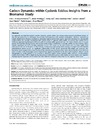Please use this identifier to cite or link to this item:
http://hdl.handle.net/10553/12381
| Title: | Carbon dynamics within cyclonic eddies: Insights from a biomarker study | Authors: | Alonso-González, Iván J. Aristegui, Javier Lee, Cindy Sánchez-Vidal, Anna Calafat, Antoni Fabrés, Joan Sangrá Inciarte, Pablo Mason, Evan |
UNESCO Clasification: | 251001 Oceanografía biológica | Keywords: | Subtropical North-Atlantic Coastal Transition Zone Time-Series Organic-Matter Sediment Traps, et al |
Issue Date: | 2013 | Journal: | PLoS ONE | Abstract: | It is generally assumed that episodic nutrient pulses by cyclonic eddies into surface waters support a significant fraction of the primary production in subtropical low-nutrient environments in the northern hemisphere. However, contradictory results related to the influence of eddies on particulate organic carbon (POC) export have been reported. As a step toward understanding the complex mechanisms that control export of material within eddies, we present here results from a sediment trap mooring deployed within the path of cyclonic eddies generated near the Canary Islands over a 1.5-year period. We find that, during summer and autumn (when surface stratification is stronger, eddies are more intense, and a relative enrichment in CaCO3 forming organisms occurs), POC export to the deep ocean was 2–4 times higher than observed for the rest of the year. On the contrary, during winter and spring (when mixing is strongest and the seasonal phytoplankton bloom occurs), no significant enhancement of POC export associated with eddies was observed. Our biomarker results suggest that a large fraction of the material exported from surface waters during the late-winter bloom is either recycled in the mesopelagic zone or bypassed by migrant zooplankton to the deep scattering layer, where it would disaggregate to smaller particles or be excreted as dissolved organic carbon. Cyclonic eddies, however, would enhance carbon export below 1000 m depth during the summer stratification period, when eddies are more intense and frequent, highlighting the important role of eddies and their different biological communities on the regional carbon cycle. | URI: | http://hdl.handle.net/10553/12381 | ISSN: | 1932-6203 | DOI: | 10.1371/journal.pone.0082447 | Source: | Plos One [ISSN 1932-6203],v. 8 (12) | Rights: | by-nc-nd |
| Appears in Collections: | Artículos |
SCOPUSTM
Citations
13
checked on Mar 30, 2025
WEB OF SCIENCETM
Citations
16
checked on Mar 30, 2025
Page view(s)
71
checked on Aug 19, 2023
Download(s)
141
checked on Aug 19, 2023
Google ScholarTM
Check
Altmetric
Share
Export metadata
Items in accedaCRIS are protected by copyright, with all rights reserved, unless otherwise indicated.
